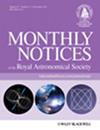Determining cosmological growth parameter for stellar - mass black holes
IF 4.7
3区 物理与天体物理
Q1 ASTRONOMY & ASTROPHYSICS
引用次数: 0
Abstract
It has recently been suggested that black holes (BHs) may grow with time, so that their mass is proportional to the cosmological scale factor to the power n, with suggested values n ≈ 3 for supermassive BHs in elliptical galaxies. Here we test these predictions with stellar mass BHs in X-ray binaries using their masses and ages. We perform two sets of tests to assess the compatible values of n. First, we assume that no compact object grows over the Tolman-Oppenheimer-Volkof limit which marks the borderline between neutron stars and BHs. We show that half of BHs would be born with a mass below this limit if n = 3 applies. The possibility that all BHs were born above the limit is rejected at 4 σ if n = 3 applies. In the second test, we assume that masses of BHs at their formation stay the same over cosmic history. We compare the mass distribution of the youngest BHs, which could have not grown yet, to their older counterparts. Distributions are compatible for $n = -0.9^{+1.3}_{-4.6}$, with n = 3 excluded formally with 87% confidence. This result may be biased, because massive BHs tend to have a massive companion. Correcting for this bias yields n ≈ 0. We can therefore conclude that while our results are not a clear rejection of BH scaling with n = 3, we show that n = 0 is much more consistent with the data.确定恒星质量黑洞的宇宙学增长参数
最近有人提出,黑洞(BHs)可能会随着时间的推移而增长,因此它们的质量与宇宙尺度因子的幂 n 成正比,对于椭圆星系中的超大质量黑洞,建议值 n ≈ 3。在这里,我们用X射线双星中恒星质量的BH的质量和年龄来检验这些预测。我们进行了两组测试来评估n的兼容值。首先,我们假定没有紧凑的天体生长超过托尔曼-奥本海默-沃尔科夫极限(Tolman-Oppenheimer-Volkof limit),该极限标志着中子星和BHs之间的边界。我们的研究表明,如果 n = 3 适用,一半的 BHs 在诞生时的质量会低于这个极限。如果 n = 3 适用,在 4 σ 时,所有诞生的 BH 都高于极限的可能性被否定。在第二个测试中,我们假定在整个宇宙历史中,BH 形成时的质量保持不变。我们将可能尚未长大的最年轻的黑体的质量分布与它们较老的质量分布进行比较。在n=-0.9^{+1.3}_{-4.6}$时,两者的质量分布是一致的,其中n=3被正式排除在外,置信度为87%。这个结果可能是有偏差的,因为大质量的黑体往往有一个大质量的伴星。因此,我们可以得出结论,虽然我们的结果并没有明确地否定n = 3的BH缩放,但我们表明n = 0与数据更为一致。
本文章由计算机程序翻译,如有差异,请以英文原文为准。
求助全文
约1分钟内获得全文
求助全文
来源期刊

Monthly Notices of the Royal Astronomical Society
ASTRONOMY & ASTROPHYSICS-
CiteScore
9.10
自引率
37.50%
发文量
3198
审稿时长
3 months
期刊介绍:
Monthly Notices of the Royal Astronomical Society is one of the world''s leading primary research journals in astronomy and astrophysics, as well as one of the longest established. It publishes the results of original research in positional and dynamical astronomy, astrophysics, radio astronomy, cosmology, space research and the design of astronomical instruments.
 求助内容:
求助内容: 应助结果提醒方式:
应助结果提醒方式:


